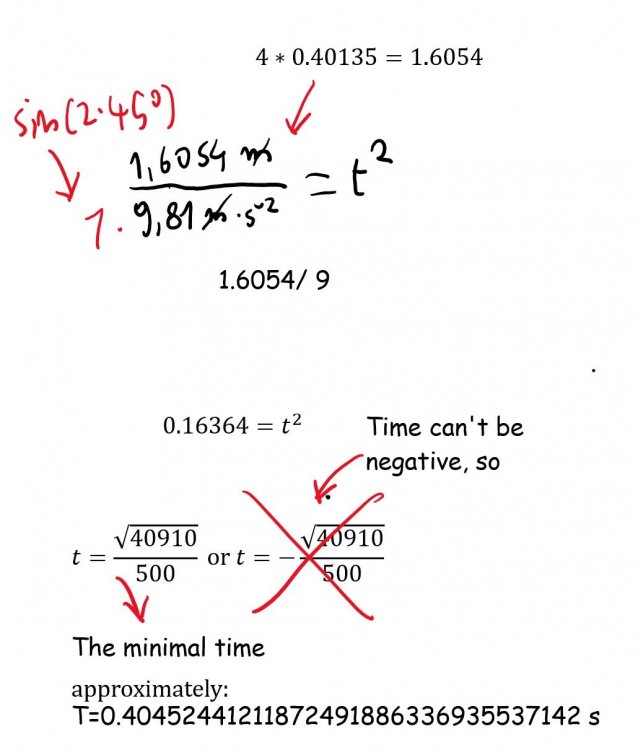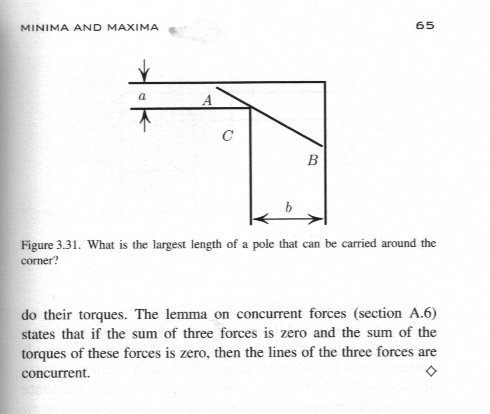

Classical Physicist
-
Posts
33 -
Joined
-
Last visited
Content Type
Profiles
Forums
Events
Posts posted by Classical Physicist
-
-
9 hours ago, studiot said:
I owe you a complete apology because I did not read your opening post properly and thereby misunderstood it.
I owe you a lot for the fact that You are willing to help me understand it, by a TON! I am extremely grateful for it.
So I took a look at your notes here, and As I understand the ideal θ will be equal to θ=45o, because sin(2*45o)= 1, so the best possible value that can be in the denominator,
Plugging those values in, I got these results:9 hours ago, studiot said:Now the answer of a Physicist who does not want to do calculus might look at this equation and say
"If t2 is a minimum then t is a minimum at the same point or value of θ
4b/g is a constant so the minimum occurs when sin2θ is a maximum
Drawing up a table of values of sin2θ as on the right tells me that this happens at around θ = 40o
Or I can plot these and get a more accurate answer at 45o." (Physics)Our Mathematician on the other hand may well differentiate the equation to find that same minimum at dt/dθ or d(t2)/dθ. (Maths)
We can plough through that maths if you like.
Sure as Hell I would, because I don't get the kind of differentiation we can do here, - especially here with the respect to certain variables, I see you went for differentiating with respect to the angle --- dθ, and so the left hand side sure is d(t2)/dθ , but right side is simply the 4b/g *1/sin(2θ) - so it would get messy, (correct me if I'm wrong)
9 hours ago, studiot said:Finally since you like this sort of thing, have a look at the book by Mark Levi
Here is an extract from his chapter on maxima and minima
Also this leaves me wondering, are you referring to the 3.30 problem or 3.31 as in the figure above? By reading it- I get even more confused, because why on earth would you want to depict the distance by a moving mechanism of a piston? - Sorry for being rough but it's quite funny way to measure the distance.
I just don't understand how it is related to finding the shortest possible time? sorry for "being ignorant", but I'm trying as much as I can. 0
0 -
Quote
What kinematic equations do you know connecting distance, time and acceleration?
the basic ones? quite a few
that's the most general an basic one
x(t)= x0+v0xt+(axt2/2)alternatively since we don't deal with any quadratic function over here :
x(t)= x0 +vtby the way I am new here and for some reason can't have more than five post for now - I think you'd have to help me get some points or idk, just so that i can post here
0 -
yes!... my concentration right now is very "diffused" if that makes sense- basically I'm trying to do as many problems as I can, without giving too much attention to the details… So Sorry for taking a lot of time to respond, I'll try to limit myself down to this problem right now… hah, I'm seeing you're from UK, so Right now it's quite late (presumably close to midnight ) So I understand you won't be able to respond for some time, so if you don't mind me asking... when will you have some free time so that you'll be active on this forum?
 0
0 -
56 minutes ago, studiot said:
Let θ be the angle of inclination of the plane.
Then the vertical distance the block falls = ??? (for you to fill in)
So I shall use the basic trig here right? Assuming inclined plane has a shape of right triangle with base b, hypotenuse c and height x (vertical distance)
We get cos (θ)=x/c ===> cos (θ)*c=x , and now the kinematics… Right?0 -
Thanks! Had no idea that it's related to the brachistochrone problem. How would you go about Solving this? Possibly using the "more basic" maths?
0 -
A small block was placed on a smooth inclined plane. The horizontal block distance from the lower end of the incline is b = 40.135 cm. The angle of inclination was adjusted so that the sliding time of the block was as short as possible, each time placing the block so that the distance b did not change. find the shortest possible sliding time T of the block.
Assume that the acceleration due to gravity is g = 9.81 m /s2. Skip friction and air resistance.
Any hints Highly appreciated. I just have a problem with correlating the distance b with the maximum angle possible to make the block even slide from the ramp.
1



Interesting Inclined Plane Problem
in Classical Physics
Posted
Hey, I am awaiting your response!